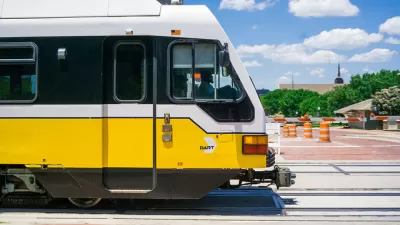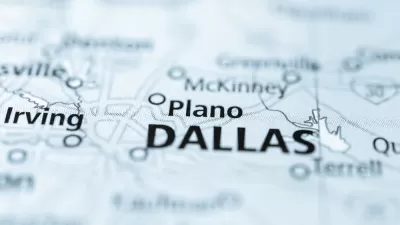The suburban city of Plano, Texas, located outside of Dallas, approved this week a comprehensive plan that overcame vocal opposition to the idea of mixed-use, urban developments.
"There is a battle raging in Plano, a healthy and necessary one, as the suburban city moves forward with its new comprehensive plan," reports Peter Simek, before providing commentary on the political debate that surrounded the Plano Tomorrow Comprehensive Plan process.
According to Simek, hundreds of residents showed up the council hearing to oppose the plan. Why? "The new plan sets an ambitious course for a more urban future in the community that, through the 1980s and 1990s, served as DFW’s archetypal suburban community. The new land use proposals still call for reserving a little over 50 percent of Plano’s land for suburban neighborhoods. But the city that is running out of vacant land also hopes to add a lot of dense, mixed-use infill development."
Simek goes on to focus on a few of what he considers to be smart details found in the plan, including its focus on community design (i.e., "laying out acceptable block sizes and street lengths, offering guidelines that discourage surface lots and encourage parking to be placed behind new developments, presenting architectural requirements, and putting forth all the increasingly standard urban design criteria which attempt to encourage more walkable, human-scaled development"). The plan is also laudable, according to Simek, for its focus on how to implement the vision put forth by the comprehensive plan.
For more on the political process, and outcry of opposition, leading to the approval of the plan, see reporting by Kristen Taketa for The Dallas Morning News.
FULL STORY: Plano Just Showed Dallas How to Run a City

Alabama: Trump Terminates Settlements for Black Communities Harmed By Raw Sewage
Trump deemed the landmark civil rights agreement “illegal DEI and environmental justice policy.”

Study: Maui’s Plan to Convert Vacation Rentals to Long-Term Housing Could Cause Nearly $1 Billion Economic Loss
The plan would reduce visitor accommodation by 25% resulting in 1,900 jobs lost.

Why Should We Subsidize Public Transportation?
Many public transit agencies face financial stress due to rising costs, declining fare revenue, and declining subsidies. Transit advocates must provide a strong business case for increasing public transit funding.

Paris Bike Boom Leads to Steep Drop in Air Pollution
The French city’s air quality has improved dramatically in the past 20 years, coinciding with a growth in cycling.

Why Housing Costs More to Build in California Than in Texas
Hard costs like labor and materials combined with ‘soft’ costs such as permitting make building in the San Francisco Bay Area almost three times as costly as in Texas cities.

San Diego County Sees a Rise in Urban Coyotes
San Diego County experiences a rise in urban coyotes, as sightings become prevalent throughout its urban neighbourhoods and surrounding areas.
Urban Design for Planners 1: Software Tools
This six-course series explores essential urban design concepts using open source software and equips planners with the tools they need to participate fully in the urban design process.
Planning for Universal Design
Learn the tools for implementing Universal Design in planning regulations.
Smith Gee Studio
Alamo Area Metropolitan Planning Organization
City of Santa Clarita
Institute for Housing and Urban Development Studies (IHS)
City of Grandview
Harvard GSD Executive Education
Toledo-Lucas County Plan Commissions
Salt Lake City
NYU Wagner Graduate School of Public Service




























